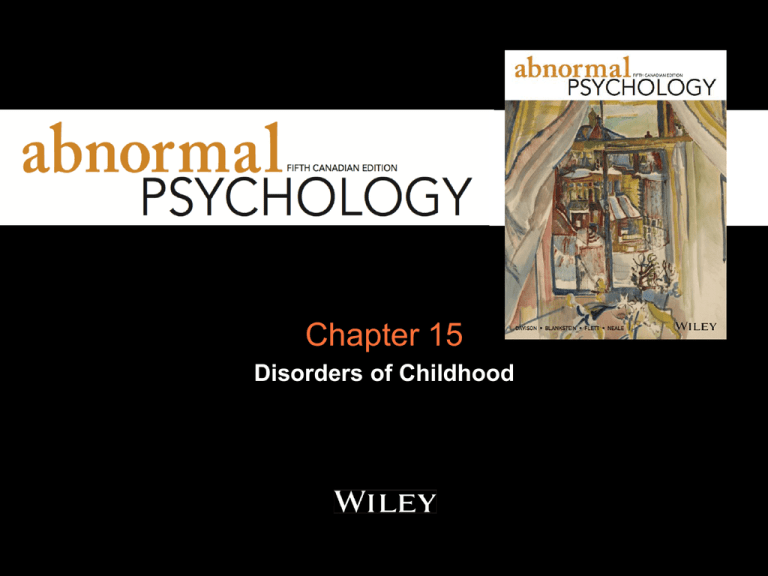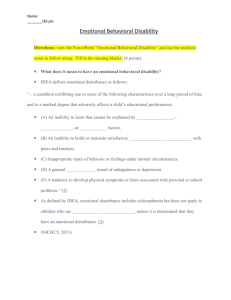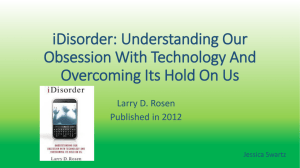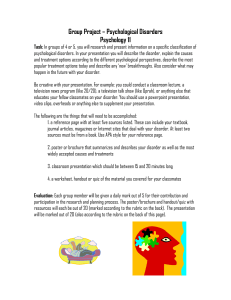
Chapter 15
Disorders of Childhood
Chapter Outline
•
•
•
•
Classification of Childhood Disorders
Neurodevelopmental Disorders
Disorders of Uncontrolled Behaviour
Disorders of Overcontrolled Behaviour
Mental Health Crisis
among children and adolescents
•
14% of Canadian children have clinical disorders
that cause significant distress and impairment
•
•
•
•
•
anxiety disorders are most prevalent
mental health problems are leading cause of
health problems after infancy in Canada
70% of adults with mental health problems had
symptom onset prior to age 20 (Canadian data)
Only 20% of young people actually get the
mental health treatment they need (Canada)
About 1/3 adolescents with a identifiable mental
disorder actually received services for the
disorder (US data)
Neurodevelopmental Disorders
DSM-5
• Attention-Deficit/Hyperactivity Disorder (ADHD)
• Learning Disorders
• Communication Disorders
• Motor Disorders
• Intellectual Disability
• Autism Spectrum Disorders
Attention-deficit/hyperactivity disorder
(ADHD)
•
•
Attention Deficits
•
•
•
•
•
Not recognized until research by Virginia Douglas
Difficulty concentrating on tasks
Difficulty sustaining attention over time
Trouble following through on instructions
Forgetful in daily activities
Hyperactivity and Impulsivity
•
•
•
•
‘constantly in motion’, jiggling legs, fidgeting, talking out of turn
trouble sitting still
Unable to stop moving or talking when asked to be quiet
Activities and movements seem haphazard
ADHD (cont.)
• Children with ADHD have:
•
•
•
Peer-relations difficulty since their behaviour can be
annoying to others
Learning disabilities in 15-30%
Comorbidity with conduct problems and oppositional
behaviour
• Prevalence world-wide: 5.29%
• Prevalence in adults: 4.4%
• More common in boys than girls but this may be
overestimated because of higher likelihood of
associated aggression in boys
Biological Theories of ADHD
•
•
Genetic predisposition
•
•
•
ADHD is considered to be one of the most heritable
phenotypes
Estimates of heritability: 75%
Cognitive marker of genetic risk: Inhibitory control deficit in both
children with ADHD and their parents
Differences in brain structure and function
•
•
•
•
•
Implication of frontal striatal circuitry
Reductions in volume in cerebrum and cerebellum
Delays in cortical maturation
Smaller basal ganglia volumes
Dysfunctions in dopaminergic and noradrenergic systems
ADHD Theories (cont.)
•
Popular explanations relate to the role of
environmental toxins but scientific research
has provided mixed evidence
Psychological Theories of ADHD
•
Diathesis-stress theory of ADHD
•
•
•
Hyperactivity develops when predisposition to disorder
is coupled with an authoritarian upbringing (Bettelheim)
Attention-seeking and hyperactivity
Reinforced by getting attention, thus increasing
(mis)behaviours in frequency or intensity
Note. These psychological theories are not
supported by research
Treatment of ADHD
•
•
•
Fewer than half of those with ADHD actually
receive treatment
Stimulant Drugs
•
•
•
Drugs such as Methylphenidate (Ritalin) used to
reduce attention deficit
Side effects: sleep problems, loss of appetite
prescriptions in recent years, are stimulant
medications for ADHD being overprescribed?
Psychological Treatment
•
•
Parent training and changes in classroom management
based on operant conditioning principles
Reinforcement for behaving appropriately
Specific Learning Disorders
•
•
•
•
•
•
Previously termed learning disabilities (DSM-IV-TR)
Inadequate development in specific area of academic,
language, speech, or motor skills
Not due to mental retardation, autism, a demonstrable
physical disorder, or deficient educational opportunities
Usually have average or above-average intellect
Prevalence: 5% or higher
School experience tends to be quite negative unless
identified and accommodations are provided
Specific Learning Disorders (Cont.)
Categories of Specific Learning Disorders:
•
•
•
Reading disorder
•
•
Difficulty with word recognition and reading
comprehension
Also known as dyslexia
Mathematics disorder
•
•
Difficulties rapidly and accurately recalling arithmetic
facts, counting objects correctly and quickly, or aligning
numbers in columns
Also known as dyscalculia
Disorder of written expression
•
•
Difficulties in composing written words
Spelling errors, errors in grammar, or very poor
handwriting
Etiology of Learning Disorders
•
Biological Factors
•
•
•
•
•
Heritable component
Chromosome 13 (13q21) is implicated in dyslexia
Generalist Genes Hypothesis
•
•
Genes for learning abilities are also responsible for learning
disabilities
Genes that influence one learning disability also influence
others
Brain Structure Differences
•
•
Left temporo-parietal cortex ↓ activation in LD
Brain area responsible for ‘phonological awareness’
Role of Family
•
•
Parents with learning disorders have trouble helping children with
school projects
↑ problems when parents do not read to children
Treatment of Learning Disorders
•
•
•
•
Most often occurs within special-education
programs in the public schools
Individualized programs should be implemented
Duration of treatment should match the severity of
the LD
Parental involvement is essential
Communication Disorders
• Language Disorder
• Child sees a car but has trouble communicating the word for it
• Speech Sound Disorder (Phonology Disorder)
•
•
Says Wabbit not rabbit; bu not blue
Resolves (disappears) over time typically
Communication Disorders (Cont.)
•
Childhood Onset Fluency Disorder (Stuttering)
•
Social (Pragmatic) Communication Disorder
•
•
•
•
•
“go” – instead go go go go go go
More common in boys than girls
Most recover
Newly added to DSM-5
Controversy: Is it really needed as a separate category or do only
individuals with autism spectrum disorders show this pattern of
being talkative but socially awkward in conversational responses
(both verbal and non-verbal)
Motor Disorders
•
•
•
Developmental Coordination Disorder
•
•
Marked impairment in motor coordination, such as troubles
tying shoelaces, buttoning shirts
Diagnosis only made if significant impairment
Tics: involuntary, repetitive movements or vocalizations
•
•
Examples of Motor tics: Eye blinking, facial grimacing, head
jerking, foot tapping, nostril flaring
Examples of Vocal tics: Coughing, grunting, throat clearing,
sniffling, sudden stereotyped outbursts of words
Tourette’s disorder: multiple motor tics and one or
more vocal tics
Intellectual Disability Disorder
•
•
•
Previously termed Mental Retardation
Significant limitations in intellectual functioning and
adaptive behaviour
Diagnostic Criteria
1. Intelligence-Test Scores (IQ = 70 or lower)
2. Adaptive Functioning (deficits in conceptual
social skills and practical skills)
3. Age of Onset (before age 18)
•
Prevalence in general population: 3%
skills,
•
•
Classification
Intellectual Disability Disorder
Four levels of intellectual disability disorder (DSM-5):
Mild (most common), moderate, severe, profound
Use both IQ scores and adaptive functioning to determine severity
levels
Previous DSM-IV-TR classifications (IQ score based):
•
Mild mental retardation
• 50–55 to 70 IQ
• 85% of people with Intellectual Disability
• Moderate mental retardation
• 35-40 to 50-55 IQ
• 10% of people with Intellectual Disability
• Severe mental retardation
• 20-25 to 35-40 IQ
• 3 to 4% of people with Intellectual Disability
• Profound mental retardation
• below 20 to 25 IQ
• 1-2% of people with Intellectual Disability
Etiology
Intellectual Disability Disorder
• No Identifiable Etiology (30 – 40%)
• 30-40% of cases have no identifiable etiology
• Heredity Disorders (5%)
•
•
•
•
•
Genetic or Chromosomal Anomalies
•
Phenylketonuria (PKU); Fragile X syndrome
Early alterations of embryonic development (about 30%)
•
Down syndrome, or trisomy 21; maternal alcohol consumption
Late pregnancy and perinatal problems (10%)
•
Fetal malnutrition, placental insufficiency, prematurity, low birth
weight, viral and other infections (e.g., HIV infection)
Medical conditions in childhood and accidents (5%)
•
Infectious diseases, traumas, toxins such as lead poisoning
Environment Influences (15-20%)
•
•
Deprivation, lack of nurturance, reduced stimulation
Effects of ↓ socio-economic conditions
Prevention and Treatment
Intellectual Disability
•
•
Environmental
Interventions and
Enrichment
Programs
Residential
Treatment
•
Behavioural
Interventions Based
on Operant
Conditioning
•
•
Applied Behaviour
Analysis
Cognitive
Interventions
•
Self-instructional
training
Autism Spectrum Disorder (ASD)
•
•
•
Previously termed pervasive developmental
disorders
Consisted of several subcategories, including
autistic disorder (autism), Asperger’s Disorder,
Rett’s disorder, childhood disintegrative disorder ,
pervasive developmental disorder – not otherwise
specified
DSM-5 eliminated subcategories since distinctions
found to be ‘inconsistent’, more related to:
•
symptom severity levels, language levels, intellectual
levels
• Prevalence is increasing
• 4/10,000 (1970s and 1980s) to current 62/10,000 (2012)
• Sex ratio: more boys than girls (4:1)
• Onset: infancy and early developmental period
• Comorbidity: depression, anxiety, ADHD
Autism Spectrum Disorder (ASD)
Characteristics
•
•
•
•
•
•
Deficits in social communication and social
interaction (may include absence of interest in
peers)
Troubles adjusting behaviour in changing
social contexts,
Limited imaginative play
Repetitive and rigid behaviour (insistence on
sameness)
Strong attachment to particular objects
Unusual motor movements (self-stimulatory
behaviours such as jumping, arm flapping)
Pervasive Developmental Disorder
(based on DSM-IV-TR categories – now eliminated)
Rett’s Disorder
•
•
•
•
•
•
•
Very rare; found only in
girls
Development normal
until 1st-2nd year of
life
Head growth
decelerates
Loses ability to use
hands purposefully
Stereotyped movements
such as handwringing or
handwashing
Walks in an
uncoordinated manner
Poor speech
Childhood Disintegrative
Disorder
•
•
Very rare
Normal development in the
first 2 years of life then
significant loss of:
•
Social, play, language, and
motor skills
Asperger’s Syndrome
•
•
•
•
Now regarded as a mild form
of autism spectrum disorder
Poor social relationships
Stereotyped behaviour
Language and intelligence
are intact
Characteristics of ASD (Cont.)
• ASD and Intellectual Disability
• 80% of ASD score below 70 on standardized IQ tests
• Extreme Autistic Aloneness
•
•
•
•
Rarely engage others in play
Fail to offer spontaneous greetings
Communication Deficits
•
•
Echolalia echo speech - Do you want a cookie? Do you want a
cookie?
Pronoun reversal refer to themselves as he, she, you
Obsessive-Compulsive and Ritualistic Acts
•
•
Upset easily over changes
Prone to stereotypic behaviour
Etiology of ASD
•
•
Psychological bases
Psychoanalytic and behavioural perspectives
believed that parents play a crucial role in ASD
Biological bases
•
•
•
Genetic Factors
Risk of autism in siblings of people with the disorder is about
75 times greater
•
•
Fragile X syndrome; Chromosomal abnormalities
Linked genetically to broader spectrum of deficits in
communicative and social areas
Etiology of ASD (Cont.)
•
Neurological Factors and Environmental Risks
•
•
•
•
Epileptic seizures (30% of adolescents with ASD)
Abnormal brainwave patterns
Larger brains but reduced brain volume
Possible brain regions implicated include:
•
•
•
Cerebellum
Amygdala and corpus callosum
Medial frontal cortex and medial temporal cortex
Treatment of ASD
•
•
Early intervention is critical to providing a better
chance of success in school and in living
independently
Most effective treatments use modelling and
operant conditioning techniques
•
•
•
•
Early intensive behavioural intervention (EIBI)
Most effective if delivered early (start before age 5),
intensively (20 hours or more per week for more than
two years)
Children with higher initial cognitive levels and fewer
early social interaction deficits show best response to
IBI
Most commonly used medications for treating
problem behaviours in autistic children are antipsychotics
Disorders of Undercontrolled Behaviour
•
•
•
•
•
Also known as ‘externalizing’ problems
New DSM-5 Classification category: Disruptive,
Impulse-Control, and Conduct Disorders
Includes several DSM-IV-TR conditions
previously in:
•
•
•
Disorders Usually First Diagnosed in Infancy,
Childhood and Adolescence
Impulse Control Disorders
these two categories have been eliminated in DSM-5
Oppositional Defiant Disorder
Conduct Disorder
Oppositional Defiant Disorder (ODD)
•
•
•
Three main themes:
•
•
•
Pattern of disobedient, hostile, and defiant behaviour
towards authority figures
angry irritable mood
vindictiveness
Examples: argumentative, blaming, resentful,
spiteful, defy adult requests
Children with ODD do NOT demonstrate serious
violations of societal norms (these are seen in
conduct disorder)
Conduct Disorder (CD)
•
•
•
•
More severe than ODD
Marked by callousness, viciousness, lack of
remorse
Repetitive pattern of behaviour that includes:
•
•
•
•
•
bullying, threatening, cruel
Destruction of property
Deceitfulness or theft
Serious violations of rules, rights of others
CD is a criteria for anti-social personality disorder
(APD)
•
•
Aggression to people and animals
Predisposing factor, not necessarily inevitable that CD
→ APD
Comorbidity: ODD, ADHD
Etiology of CD
•
Biological Factors
•
•
•
Genetic influence
•
•
Aggressive behaviour clearly heritable
Delinquent behaviour seems not to be heritable
Neuropsychological deficits
•
Poor verbal skills, difficulty w/ executive functioning,
problems w/ memory
Neurological correlates (brain imaging studies)
•
Possible amygdala dysfunction
Etiology of CD (cont.)
•
Psychological Factors
• Hostile/ineffective parenting practices
• inconsistent parental discipline and parental
adjustment difficulties
• Learning theories
• Modelling and operant conditioning
• Cognitive Biases
•
•
•
Social-information processing theory
Mistakenly view neutral peer behaviour as
aggressive/threatening
Chaotic social environment
•
Noise levels, crowding, unpredictability in home and
neighbourhood
Biopsychosocial Model of CD
Course and Treatment of CD
• Some improvements seen when issues
addressed at younger age
• Severe cases typically persist and develop into
APD in adulthood
• Family Interventions
• Parental Management Training
• Multi-systemic Treatment
• Cognitive Approaches
•
•
Anger management
Moral reasoning skills training
Prevention of CD
•
•
•
Beginning treatment before age 3
Identifying families and mothers at risk
Prenatal and postnatal risks in mother:
•
•
•
•
•
•
Maternal antisocial behaviour
Young age of pregnancy
smoking during pregnancy
Maternal depression soon after birth
Partner cruelty
Harsh parenting
Disorders of Overcontrolled
Behaviour
•
•
Also known as ‘internalizing’ problems
No longer Childhood Disorders Classification
(DSM-IV-TR), instead childhood onset is
specified in DSM-5 Diagnosis for the Disorder
condition (DSM-5 categories now used for both
children and adults)
Disorders of Overcontrolled
Behaviour (cont.)
•
•
•
•
•
•
•
•
•
Separation Anxiety (now included among
Anxiety Disorders)
Social Anxiety
Selective Mutism
Specific Phobia
Generalized Anxiety Disorder
Obsessive-Compulsive Disorder
Post-Traumatic Stress
Panic Disorder
Depression
Disruptive Mood Dysregulation
Disorder
•
•
•
•
•
Controversial new DSM-5 disorder
Referred to as ‘temper tantrum disorder’
persistent irritability
Episodes of temper outbursts, three or more
times per week
Considered to be a kind of mood (depressive)
disorder
Childhood Fears and Anxiety
Disorders
•
•
•
•
•
Most children experience fears and worries as
part of normal development
One-third of Canadian children (ages 4 -11) rated
by parents as too fearful or anxious
Fears and phobias reported more often for girls
than for boys
10 to 15% of children and adolescents have an
anxiety disorder
Most common disorders of childhood
Separation Anxiety Disorder
•
•
Unrealistic concern about separation from major
attachment figures
Symptoms associated with SAD must be
experienced for at least four weeks
•
•
•
•
•
•
Unrealistic and persistent worries about harm to major
attachment figures
Fears of abandonment
Refusal to attend school
Avoidance of being alone
Experience of nightmares involving separation themes
Experience of physical complaints in anticipation of
being separated from attachment figures
Social Phobia
•
•
•
•
Also known as social anxiety
Extremely quiet, shy, avoid strangers
May include selective mutism
•
Refusal to speak when it is expected of a person
Example: refusing to speak to a teacher
•
Theories of social phobia in children
•
•
Individual differences in behavioural inhibition
Higher risk when parent has social phobia
Treatment of Fears and Phobias
•
•
•
Similar to that employed with adults
Exposure to feared object while performing
some action to inhibit their anxiety
CBT shows great promise in treating childhood
anxiety
Copyright
•
Copyright © 2014 John Wiley & Sons Canada, Ltd. All rights
reserved. Reproduction or translation of this work beyond that
permitted by Access Copyright (The Canadian Copyright
Licensing Agency) is unlawful. Requests for further information
should be addressed to the Permissions Department, John
Wiley & Sons Canada, Ltd. The purchaser may make back-up
copies for his or her own use only and not for distribution or
resale. The author and the publisher assume no responsibility
for errors, omissions, or damages caused by the use of these
programs or from the use of the information contained herein.








